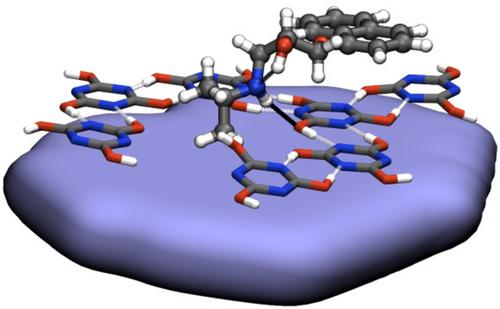当前位置:
X-MOL 学术
›
Electroanalysis
›
论文详情
Our official English website, www.x-mol.net, welcomes your feedback! (Note: you will need to create a separate account there.)
A Voltammetric Sensory System for Recognition of Propranolol Enantiomers Based on Glassy Carbon Electrodes Modified by Polyarylenephthalide Composites of Melamine and Cyanuric Acid
Electroanalysis ( IF 3 ) Pub Date : 2017-09-13 , DOI: 10.1002/elan.201700404 Rufina A. Zilberg 1 , Artem V. Sidelnikov 1 , Valery N. Maistrenko 1 , Yulia A. Yarkaeva 1 , Edward M. Khamitov 1 , Viktor M. Kornilov 2 , Elza I. Maksutova 1
Electroanalysis ( IF 3 ) Pub Date : 2017-09-13 , DOI: 10.1002/elan.201700404 Rufina A. Zilberg 1 , Artem V. Sidelnikov 1 , Valery N. Maistrenko 1 , Yulia A. Yarkaeva 1 , Edward M. Khamitov 1 , Viktor M. Kornilov 2 , Elza I. Maksutova 1
Affiliation

|
An enantioselective voltammetric sensory system based on glassy carbon electrodes modified by polyarylenephthalide composites of melamine and cyanuric acid using chemometric method principal component analysis for the recognition of propranolol enantiomers was developed. It is shown that glassy carbon electrodes modified by polyarylenephthalide composites of melamine and cyanuric acid exhibit the properties of enantioselective sensors. The molecular dynamics simulations of the interaction processes of propranolol enantiomers with polyarylenephthalide composites of melamine and cyanuric acid show that the differences between the voltammograms of propranolol enantiomers on such electrodes are due to differences in the energy of hydrogen bonds formation between enantiomeric molecules and supramolecules of melamine and cyanuric acid. This is reflected not only in the characteristics and shape of the voltammograms, but also in the sensitivity of the electrodes, with respect to the propranolol enantiomers. The possibilities of the sensory system for express recognition of R- and S-propranolol are considered. The recognition of these enantiomers by the registered voltammograms on two glassy carbon electrodes modified by polyarylenephthalide composites of melamine and cyanuric acid allows to increase significantly the percentage of correctly recognised samples in comparison with the registration of voltammograms on only one electrode.
中文翻译:

基于三聚氰胺和氰尿酸聚亚芳基苯酞复合物改性玻璃碳电极的普萘洛尔对映体的伏安传感系统识别
开发了一种基于玻璃碳电极的对映选择性伏安传感系统,采用三聚氰胺和氰尿酸的聚亚芳基苯酞复合材料,采用化学计量学方法主成分分析来识别普萘洛尔对映体。结果表明,由三聚氰胺和氰尿酸组成的聚亚芳基苯酞复合材料修饰的玻碳电极具有对映选择性传感器的特性。普萘洛尔对映体与三聚氰胺氰尿酸聚芳苯酞复合物相互作用过程的分子动力学模拟表明,此类电极上普萘洛尔对映体伏安图的差异是由于对映体分子与三聚氰胺超分子之间形成氢键的能量不同。和氰尿酸。这不仅反映在伏安图的特性和形状上,还反映在电极对普萘洛尔对映体的灵敏度上。考虑了用于明确识别 R-和 S-心得安的感觉系统的可能性。与仅在一个电极上记录伏安图相比,通过在由三聚氰胺和氰尿酸的聚亚芳基苯酞复合材料改性的两个玻璃碳电极上记录的伏安图识别这些对映异构体,可以显着增加正确识别样品的百分比。考虑了用于明确识别 R-和 S-心得安的感觉系统的可能性。与仅在一个电极上记录伏安图相比,通过在由三聚氰胺和氰尿酸的聚亚芳基苯酞复合材料改性的两个玻璃碳电极上记录的伏安图识别这些对映异构体,可以显着增加正确识别样品的百分比。考虑了用于明确识别 R-和 S-心得安的感觉系统的可能性。与仅在一个电极上记录伏安图相比,通过在由三聚氰胺和氰尿酸的聚亚芳基苯酞复合材料改性的两个玻璃碳电极上记录的伏安图识别这些对映异构体,可以显着增加正确识别样品的百分比。
更新日期:2017-09-13
中文翻译:

基于三聚氰胺和氰尿酸聚亚芳基苯酞复合物改性玻璃碳电极的普萘洛尔对映体的伏安传感系统识别
开发了一种基于玻璃碳电极的对映选择性伏安传感系统,采用三聚氰胺和氰尿酸的聚亚芳基苯酞复合材料,采用化学计量学方法主成分分析来识别普萘洛尔对映体。结果表明,由三聚氰胺和氰尿酸组成的聚亚芳基苯酞复合材料修饰的玻碳电极具有对映选择性传感器的特性。普萘洛尔对映体与三聚氰胺氰尿酸聚芳苯酞复合物相互作用过程的分子动力学模拟表明,此类电极上普萘洛尔对映体伏安图的差异是由于对映体分子与三聚氰胺超分子之间形成氢键的能量不同。和氰尿酸。这不仅反映在伏安图的特性和形状上,还反映在电极对普萘洛尔对映体的灵敏度上。考虑了用于明确识别 R-和 S-心得安的感觉系统的可能性。与仅在一个电极上记录伏安图相比,通过在由三聚氰胺和氰尿酸的聚亚芳基苯酞复合材料改性的两个玻璃碳电极上记录的伏安图识别这些对映异构体,可以显着增加正确识别样品的百分比。考虑了用于明确识别 R-和 S-心得安的感觉系统的可能性。与仅在一个电极上记录伏安图相比,通过在由三聚氰胺和氰尿酸的聚亚芳基苯酞复合材料改性的两个玻璃碳电极上记录的伏安图识别这些对映异构体,可以显着增加正确识别样品的百分比。考虑了用于明确识别 R-和 S-心得安的感觉系统的可能性。与仅在一个电极上记录伏安图相比,通过在由三聚氰胺和氰尿酸的聚亚芳基苯酞复合材料改性的两个玻璃碳电极上记录的伏安图识别这些对映异构体,可以显着增加正确识别样品的百分比。



























 京公网安备 11010802027423号
京公网安备 11010802027423号